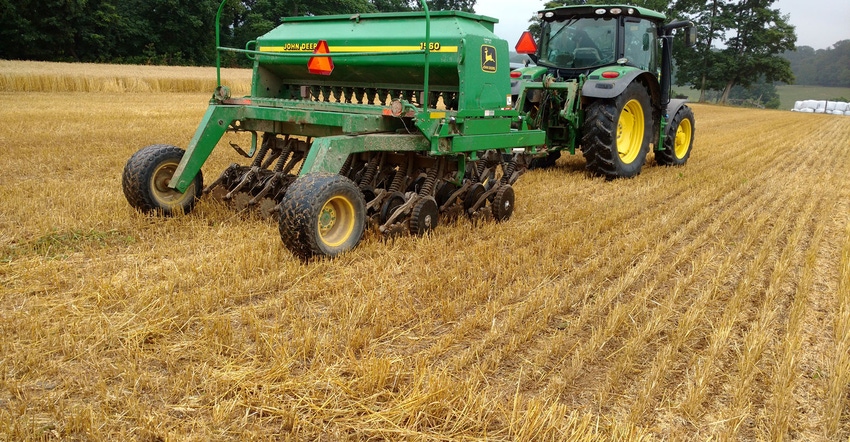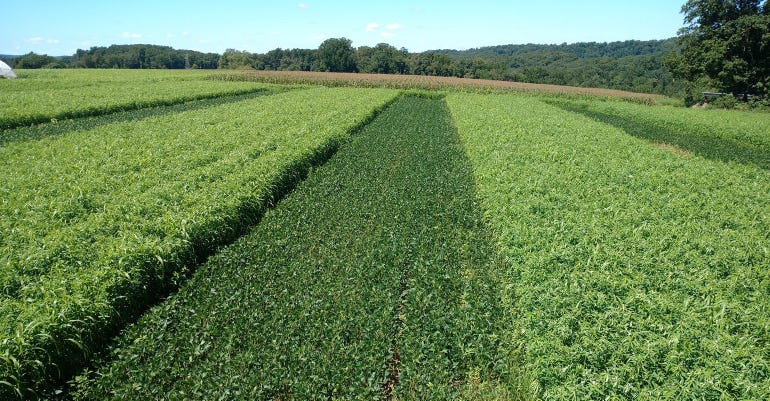May 1, 2019

I’ve decided to stop planting greedy beans.
What are greedy beans, you ask? They are simply what some call double-cropped soybeans.
Lots of farmers plant soybeans after small grains to get a cash crop harvest ahead of the following year’s corn. The rationale behind this approach makes sense. Legumes should improve the nitrogen in the soil and get it ready for corn next season.
I used to plant double-crop soybeans until I noticed something wasn’t adding up. Even though I was supposed to get some additional nitrogen from my soybeans, it wasn’t enough to lower my nitrogen application in corn the following year.
In fact, I got curious and started studying my corn yields under different conditions. I found that it didn’t matter how much N I added after soybeans; corn yields were consistently lower than when I used other practices.
Why beans don’t work
What I found instead was that the best boost for corn yields was — you guessed it — cover crops.
Double-cropping soybeans doesn’t leave a good window for planting a winter cover crop after harvest in mid-November, so the fields don’t get the residual benefits of a cover crop ahead of the next cash crop planting. Also, soybeans are hard on the soil; they don’t build carbon, and their post-harvest residue doesn’t provide much soil erosion protection.
You are also short-changing yourself on an opportunity to enhance biodiversity. Cover-cropped fields easily outperformed my bare post-soybean fields, and for me the question was settled with research conducted on my farm.
Corn yields after greedy beans
I did replicated plots with five nitrogen rates on corn following three treatments post-wheat harvest, which occurred the summer before.
The control plots were no double-crop soybeans or cover crops planted. The two additional treatments were double-crop soybeans and cover crops that included a mix of radish, sunn hemp and sorghum Sudan grass. Weeds were sprayed once in late summer.
To see the true effects of the cover crops and potential yield contribution of the double-crop soybeans, zero nitrogen plots were used for each treatment. In the zero N plots, double-crop soybeans did push the subsequent corn yield 7 bushels higher, but where the cover crop mix was planted an 11-bushel increase in corn was measured.
 COVER CROP PAYOFF: Steve Groff, who has been comparing the use of cover crops vs. double-crop soybeans on the following corn crop, has seen higher corn yields in his cover crop plots along with all the benefits of planting a cover crop.
COVER CROP PAYOFF: Steve Groff, who has been comparing the use of cover crops vs. double-crop soybeans on the following corn crop, has seen higher corn yields in his cover crop plots along with all the benefits of planting a cover crop.

Even where we applied 200 pounds of N to corn the following year — split between at planting and side-dressing — the corn still yielded 9 bushels more compared to the double-crop bean plots. But what may be more compelling is when all other N plots — 50, 100, and 150 pounds per acre — were included and averaged out, we realized a 14-bushel corn yield gain the following year!
What about profit?
You might be saying to yourself, “Yes, all that makes sense: double-cropped soybeans aren’t all they’re cracked up to be and increased subsequent corn profits may be in the ballpark of what you’d make with greedy beans.”
But don’t forget that pesticide costs may all but be eliminated with the use of a strategic cover crop mix. Overall fertilizer costs may be significant too, particularly on the following corn crop.
Forage opportunity
Some may be suited to cash-in on cover crops planted after wheat. The demand for forage in some regions provides this opportunity.
Even though it could be argued that you are taking away some soil health benefits by removing biomass from these fields, the net loss is much less than what you’d incur with greedy beans. If manure can be applied, those nutrients are certainly replaced. In fact, some really like the added window of manure application that a field with cover crops can provide.
The Coach’s Closer
Each year, I hear of a few more farmers planting less greedy beans and instead using a prime opportunity to maximize the benefits of cover crops. Why not try a field this year?
Groff is a cover crop pioneer and innovator who farms in the Chesapeake Bay Watershed. Check out his website, covercropcoaching.com.
About the Author(s)
You May Also Like




